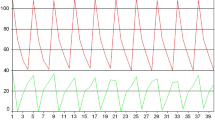Abstract
We consider repeated play of noncooperative games in which agents have more decisionsto consider at every stage than their attention allows. However, under a monotonicityassumption, if every variable is adjusted cyclically, as guided by marginal payoffs, thenmyopic steps lead to Nash equilibrium in the long run.
Similar content being viewed by others
References
H.H. Bauschke and J.M. Borwein, On projection algorithms for solving convex feasibility problems, SIAM Review 38(1996)367– 426.
M. Benaim, A dynamical system approach to stochastic approximation, SIAM J. Control and Optimization 34(1996)437 – 472.
A. Benveniste, M. Métivier and P. Priouret, Adaptive Algorithms and Stochastic Approximations, Springer, Berlin, 1990.
D.P. Bertsekas and J.N. Tsitsiklis, Parallel and Distributed Computation, Prentice-Hall, Englewoods Cliffs, NJ, 1989.
Y. Ermoliev and S.P. Uryasiev, Nash equilibrium in n-person games, Kibernetika 3(1982)85 – 88.
S.D. Flåm and C. Horvath, Network games; adaptations to Nash – Cournot equilibrium, Annals of Operations Research 64(1996)179 – 195.
S.D. Flåm, Approaches to economic equilibrium, Journal of Economic Dynamics and Control 20(1996)1505 – 1522.
D. Fudenberg and D.K. Levine, Theory of Learning in Games, Book draft, 1996.
K.C. Kiwiel, Block-iterative surrogate projection methods for convex feasibility problems, Linear Algebra and Appl. 215(1995)225 – 260.
K.C. Kiwiel, The efficiency of subgradient projection methods for convex optimization, Part I and II, SIAM J. Control and Optimization 34(1996)660 – 697.
D. Monderer and L.S. Shapley, Potential games, Games and Economic Behavior 14(1996)124 – 143.
M.J. Osborne and A. Rubinstein, Course in Game Theory, The MIT Press, London, 1994.
H. Peyton Young, Learning and Evolution in Games, Book draft, 1996.
B.T. Polyak and A.B. Juditsky, Acceleration of stochastic approximation by averaging, SIAM J. Control and Optimization 30(1992)838–855.
C.W. Sanchirico, A probabilistic model of learning in games, Econometrica 64,(1996)1375 – 1393.
N.Z. Shor, Minimization Methods for Non-Differentiable Functions, Springer, Berlin, 1985.
S.I. Zuhovickií, R.A. Poljak and M.E. Primak, Two methods of search for equilibrium points of n-person concave games, Soviet Math. Dokl 10(1969)279– 282.
J.W. Weibull, Evolutionary Game Theory, The MIT Press, London, 1995.
Rights and permissions
About this article
Cite this article
Flåm, S.D. Restricted attention, myopic play, and thelearning of equilibrium. Annals of Operations Research 82, 59–82 (1998). https://doi.org/10.1023/A:1018987409039
Issue Date:
DOI: https://doi.org/10.1023/A:1018987409039



